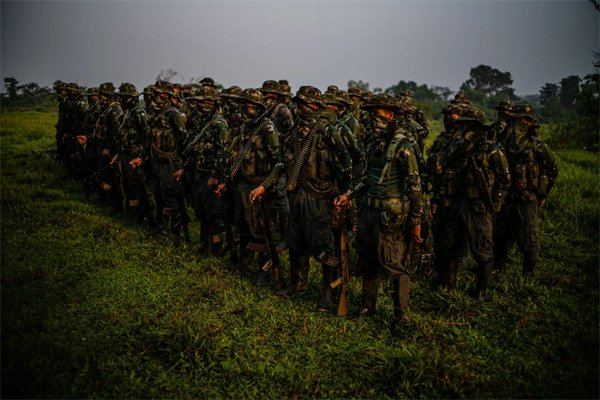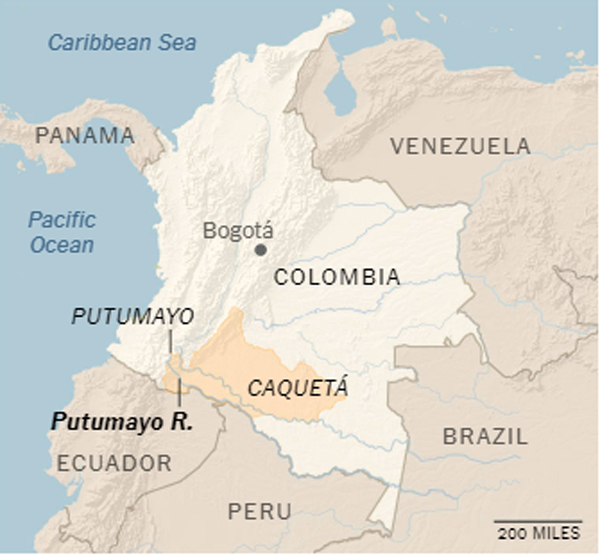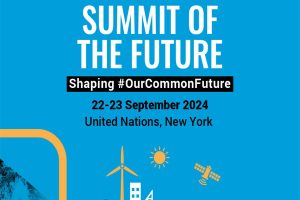
By Julie Turkewitz, NYTimes
Photographs by Federico Rios
PUTUMAYO, Colombia
EnergiesNet.com 04 21 2022
In a rebel-held town deep in the jungle, Joel ran drills beside his comrades, line after line of them in camouflage and boots, rifles at their sides.
“To the right!” their instructor shouted.
For Joel, 36, this scene was familiar. He had spent six years in the army, fighting on the front lines against a brutal insurgency that had terrorized Colombia for decades.
But now he had a new employer: an illegal armed group that included the same insurgents he had spent his military career battling to defeat.
“I know it shouldn’t be like this,” he said recently, cradling a rifle in his lap. But after he left the army, he said, he’d struggled to make ends meet. Then came an offer of a salary of $500 a month, nearly twice Colombia’s monthly minimum wage.
Now, “my children live better lives,” he said, “because I can feed them.”
Colombia’s peace accord, signed in 2016 by the government and the Revolutionary Armed Forces of Colombia, or FARC, was supposed to usher in a new era of peace in a nation that had endured more than five decades of war. The deal was that the rebels would lay down their arms, while the government would flood conflict zones with job opportunities, alleviating the poverty and inequality that had started the war.
Thousands of FARC fighters laid down their arms. But in many places, the government never arrived. Instead, many parts of rural Colombia have seen a return to the killings, displacement and violence that, in some regions, is now as bad, or worse, than before the accord.
Massacres and the killings of human rights defenders have soared since 2016, according to the United Nations. And displacement remains startlingly high, with 147,000 people forced to flee their homes last year alone, according to government data.
It’s not because the FARC, as an organized fighting force, is back. Rather, the territorial vacuum left by the old insurgency, and the absence of many promised government reforms, has unleashed a criminal morass as new groups form, and old groups mutate, in a battle to control flourishing illicit economies.
While many Colombians call these new groups “the dissidents,” a reference to FARC fighters who rejected the peace deal, their compositions are more complex. In some, former foes — rebels, soldiers and paramilitaries — as well as new recruits and organized crime members have united around the lure of a paycheck.



These fighters are now facing off against their former allies for control of a reinvigorated drug trade in a surge of unrest that looks more like gang violence than the civil insurgency that raged for so many years.
“We’re fighting comrade against comrade, battle brother against battle brother,” said Benjamin Perdomo, a founder of the Comandos de la Frontera, the militia that Joel joined six months ago, one of more than 30 armed groups that security officials say have emerged since 2016.
Like others interviewed for this article, Mr. Perdomo agreed to be identified only by his nom de guerre. Some individuals are not named to protect their lives.
In February, traveling by boat on a river network in the Amazon forest, The Times spent a week with the Comandos. We visited several towns under their control, watched them move weapons and buy drugs, and slept at a camp where fighters set off grenades and ran drills just yards from the Putumayo, a major river, no police or military in sight.
The Comandos are now fighting with the Frente Carolina Ramírez, another group headed by former guerrilla leaders, for control of Putumayo and Caquetá, two departments in the Colombian Amazon, near the border with Ecuador and Peru, that play critical roles in the drug trade.
The departments are also home to two of the country’s important industries: oil and cattle. Together, the contested territories form about 10 percent of the country.
Increasingly, it is civilians who are suffering most, trapped between these warring groups and even the military trying to stop them.
Some security experts warn if the government does not take on a greater role in quelling these militias and fulfilling the promises of the accord, the country could be headed toward a state that looks more like Mexico — ravaged by drug gangs vying for territory — than the Colombia of the 2000s.
“It’s a long way to go to get back to 2002,” said Adam Isacson, director for defense oversight at the Washington Office on Latin America, referring to the casualty counts during one of the worst years of the war. “But we’re on that path right now.”
‘Everything Is About the Money.’
By the time the Comandos spilled into a riverside town on a recent Sunday, the community was already in full weekend swing — music blared from a sound system and rival soccer teams took the field. The fighters, rifles on their shoulders, took up a position on an adjacent plot, where they ran drills in a show of force.
Residents watched both spectacles from the sidelines, beers and ice pops in hand.
The conflict with the FARC dates to the 1960s, when two communist leaders declared a rebellion against the state, pledging to replace the government with one that would support poor rural people.
For decades, cocaine funded the FARC’s deadly fight. Then came the peace deal, which requires the Colombian government to invest in programs that will wean rural communities off the cultivation of coca, the base product in cocaine, and starve armed groups of their income.

But this town, hours from any major city, is one of many where sustainable alternatives never arrived, and coca still dominates.
“The government hasn’t helped with anything,” said the town council president in one militia-controlled community. “For us, coca is the state.”
To many residents here, the Comandos, who formed in 2017, are just the latest militia to occupy their town. They buy their coca and have become the chief employer, the unofficial police force and even the public works administration.
When the locals follow the rules, this relationship can reach a tense symbiosis.



But when residents don’t comply — or when a rival group pushes in and tries to become the new coca buyer — the dynamic turns deadly.
Under the old FARC regime, leaders claimed that their reign of terror was in service to a higher goal. Mr. Perdomo of the Comandos makes a similar claim, saying his group is fighting for “development, progress and social justice” for poor Colombians.
But in interviews with nearly two dozen rank-and-file Comandos, few had any sense that there was a larger purpose to their work. One was a single mother who couldn’t raise her children on the $90 a month she made as a housekeeper; another was a former FARC fighter who had discovered he could make twice as much as the unit’s doctor than he could at a public hospital.
The Comandos not only pay far more than many Colombian employers, they also offer vacation time.
This, said Mr. Perdomo, has allowed the group to draw in hundreds of recruits. (A high-ranking security official declined to quantify the Comandos’ size.)
“This isn’t like a guerrilla that works for an idea,” said one fighter. “Everything is about the money.”
‘They Destroyed Our Lives in an Instant.’
Across Colombia, confrontations between armed groups are at the highest level they’ve been since the peace deal was signed, according to the Special Jurisdiction for Peace, a court created by the deal to investigate the war.
Last year, more than 13,000 people were killed, the most since 2014.
There are now six separate conflicts in the country, according to the International Committee of the Red Cross, three of which involve ex-FARC groups.
In Putumayo, the Comandos are accused of carrying out murders, forced disappearances, arbitrary detentions and the “mobilization of terror,” according to Colombia’s ombudsman’s office, which is charged with tracking human rights violations. The Carolina Ramírez is just as brutal, the ombudsman says.
In August, a small town tucked off a bend in the Putumayo River became one of the most recent to come under siege. The community, a collection of modest wooden houses, was initially held by the Comandos. But three residents described how the Carolina Ramírez entered one day before dawn, rounded up locals and insisted that they were now in charge.
One woman, so distraught that she could barely tell her story, described waking as her husband came running into their home, telling her that he was about to die. Then came the sound of bullets and fighters who threatened to bomb her house if she did not let them in.
“I opened the door and got on my knees and begged them not to kill him,” she said. Her children watched as the men dragged their father away. Weeks later, the Carolina Ramírez released a video accusing her husband of working with the Comandos — and saying that he was dead.



Another woman in a different town in Putumayo described how armed men shot and killed her mother, a local official, and her stepfather, a former FARC fighter, one evening as their family watched helplessly. She was emotionless as she told the story, her eyes fixed on the floor before her.
“They destroyed our lives in an instant,” she said.
Defense Minister Diego Molano said in an interview that the military was making “every effort” to fight these new groups by redoubling its focus on taking out ringleaders, eradicating coca and demobilizing fighters.
“In general, we’ve contained the threat,” he said.
But after a recent operation in which the military announced it had killed 11 Comandos, civil society groups claimed that several of the dead were in fact civilians — and that the attack had taken place during a town fundraiser.
Mr. Molano denied these charges. “The operation was not against peasants, but FARC dissidents,” he tweeted. “It was not against innocent Indigenous people, but drug dealers.”
Colombia’s complex security problem was never going to be solved in a four-year presidential term. But critics say this new cycle of violence is being fueled by the government’s lack of commitment to the programs in the peace deal.
President Iván Duque, a conservative, once led a campaign to change the terms of the 2016 agreement, calling it too easy on the FARC. Since taking office in 2018, he has said he embraces the accord.
The numbers, however, tell a different story, his opponents say. By the time Mr. Duque, who is restricted to a single term, took charge, 22 percent of the deal had already been fully carried out, according to the Kroc Institute for International Peace Studies. During his tenure, he increased that proportion by 8 percentage points, according to the most recent data.
Mr. Duque has said that a third of the deal’s provisions are now fully implemented, putting the country on track to complete the accord within its 15-year mandate. But he will leave office this August following plummeting approval ratings that many say reflect both security concerns and a growing frustration with the ongoing lack of decent-paying jobs.
“This government has wasted the opportunity of the accord,” said Marco Romero, the director of Codhes, a human rights group, calling the current level of violence “scandalous.”
‘Smells Like War.’
Dozens of Comandos pitched their camp near the banks of the Putumayo, laying their beds between the trees and building a kitchen by a wooden farmhouse.
Here, the fighters strung up satellite internet amid the farmers’ cows and chickens, and brought in ice cream and tamales from a nearby town. They bought thick tiles of coca paste from nearby farmers — for sale to other narco-traffickers — and tested grenade launchers meant for their enemies, the Carolina Ramírez.
“Smells like war!” someone shouted as a grenade went flying into a nearby field.
While this new generation of armed groups has been largely fractured, security experts say they are beginning to see a clearer coalescence into two factions, both led by former FARC leaders who say they want to rebuild the insurgency.
The concern, said Kyle Johnson, an analyst with Conflict Responses, a nonprofit in Colombia, is that these alliances could move the violence from a patchwork of battles between small groups to a face-off between two large ones, setting up a nationwide conflict.
“It seems like it’s hard to find a worse scenario,” than the current one, Mr. Johnson said, “but that would be a much worse scenario.”



Perhaps the biggest difference between the old FARC and the Comandos is who they’re fighting. The FARC fought the state. But the Comandos do not attack the government, or consider it their enemy, said Mr. Perdomo, who himself spent more than a decade with the FARC.
In fact, it was a threat from another ex-FARC group — “join us or we’ll kill you” — that compelled him to form the Comandos, he said.
Hundreds of former FARC fighters have been killed since the peace deal, some by their former comrades, and many human rights groups say the state’s failure to protect former combatants is helping to drive rearmament.
Mr. Perdomo said his purpose was to protect ex-combatants and everyday Colombians from the brutality of the Carolina Ramírez. The goal, he said, was to “eradicate” the rival group, and then negotiate a more robust peace deal with authorities in the capital, Bogotá.
The drug business, he added, was merely “a means” to get there.
“We’re talking about defending our lives,” he said. “We don’t care about money. The only thing we really care about is that our society of brothers finds peace.”
But security analysts point out that the Comandos’ decision not to go after the government is also very good for their business: If they don’t attack the state, they’re less likely to provoke its firepower. Though it hasn’t prevented the government from going after them.
After breakfast one day, a group of fighters broke away to prepare for their two-week vacation, changing from camouflage into jeans and T-shirts, headed back to life with their families and friends.
With the sun near its height, they wrapped their guns in plastic and affixed the packages with name tags, handing them over for safekeeping while they were away. Then they climbed into a brightly colored motorboat and sped down the Putumayo for hours on end, beers and whiskeys in hand, music roaring behind them.
“Look, partner, let me warn you,” the Comandos sang to a popular tune, “a hundred of you, we’ll cut into pieces.”

Reporting was contributed by Federico Rios.
Julie Turkewitz is the Andes bureau chief, covering Colombia, Venezuela, Bolivia, Ecuador, Peru, Suriname and Guyana. Before moving to South America, she was a national correspondent covering the American West. @julieturkewitzA version of this article appears in print on April 21, 2022, Section A, Page 1 of the New York edition with the headline: New Militias Rise to Brutalize Rural Colombia.
nytimes.com 204 20 2022







